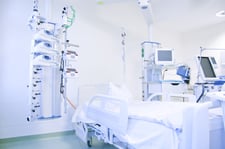One of the most vital processes within critical environments is the sterilization of medical tools and devices. Patient safety relies heavily on the efficiency and reliability of sterilization devices. Contaminants can become highly resistive to disinfection, which results in the need for high performance sterilization methods that will ensure sterile equipment. Three primary methods of medical sterilization occur from high temperature/pressure and chemical processes.
1. Plasma Gas Sterilizers
Plasma sterilization utilizes low temperature hydrogen peroxide gas plasma within a chamber to kill all living microorganisms on medical and dental equipment, including bacteria, spores, viruses, and fungi. When vaporized hydrogen peroxide is added to the chamber, equipment within the enclosure becomes sterile. Once the vapor is removed from the chamber, a low temperature plasma is produced, ensuring complete sterilization for all tools. The remnants of this process are water and oxygen, making operations safe for both medical staff and the environment. Although plasma sterilization is a more expensive method, it's highly effective and ideal for moisture sensitive medical tools.
2. Autoclaves

An autoclave is a large, steel vessel or chamber that circulates steam at high temperature and pressure to sterilize various items, or as part of an industrial process. Industrial autoclave processes may include rubber vulcanization, composite parts processing, and structural adhesive bonding. Autoclaves are one of the most economical methods of sterilization, while still having a short cycle time.
3. Vaporized Hydrogen Peroxide Sterilizers
Similar to plasma sterilization, vaporized hydrogen peroxide (VHP) sterilizers also utilize hydrogen peroxide vapor, but plasma gas isn't used within the process. VHP sterilizers remove humidity from an enclosure and hydrogen peroxide vapor is rapidly injected by a generator to reach an effective concentration to sterilize equipment. These vapors effectively remove micro-organisms that may be present, sterilizing the enclosure. The generator then reverses the process, breaking down the hydrogen peroxide vapor into environmentally friendly elements. This method has one of the lowest cycle times, resulting in the ability to sterilize equipment in high volume batches.
In order to be effective, all three methods require precise control of pressure at each step within the sterilization process. Without control of pressure levels, micro-organisms can still be present in the enclosed area, resulting in unsterile equipment. Pressure transducers provide accurate measurements of pressure, enabling all three methods to be highly effective. Since each method has unique processes for sterilization, there are many considerations to keep in mind for selecting the right pressure transducer.
CLICK HERE to download our whitepaper measuring pressure in medical sterilizers.



